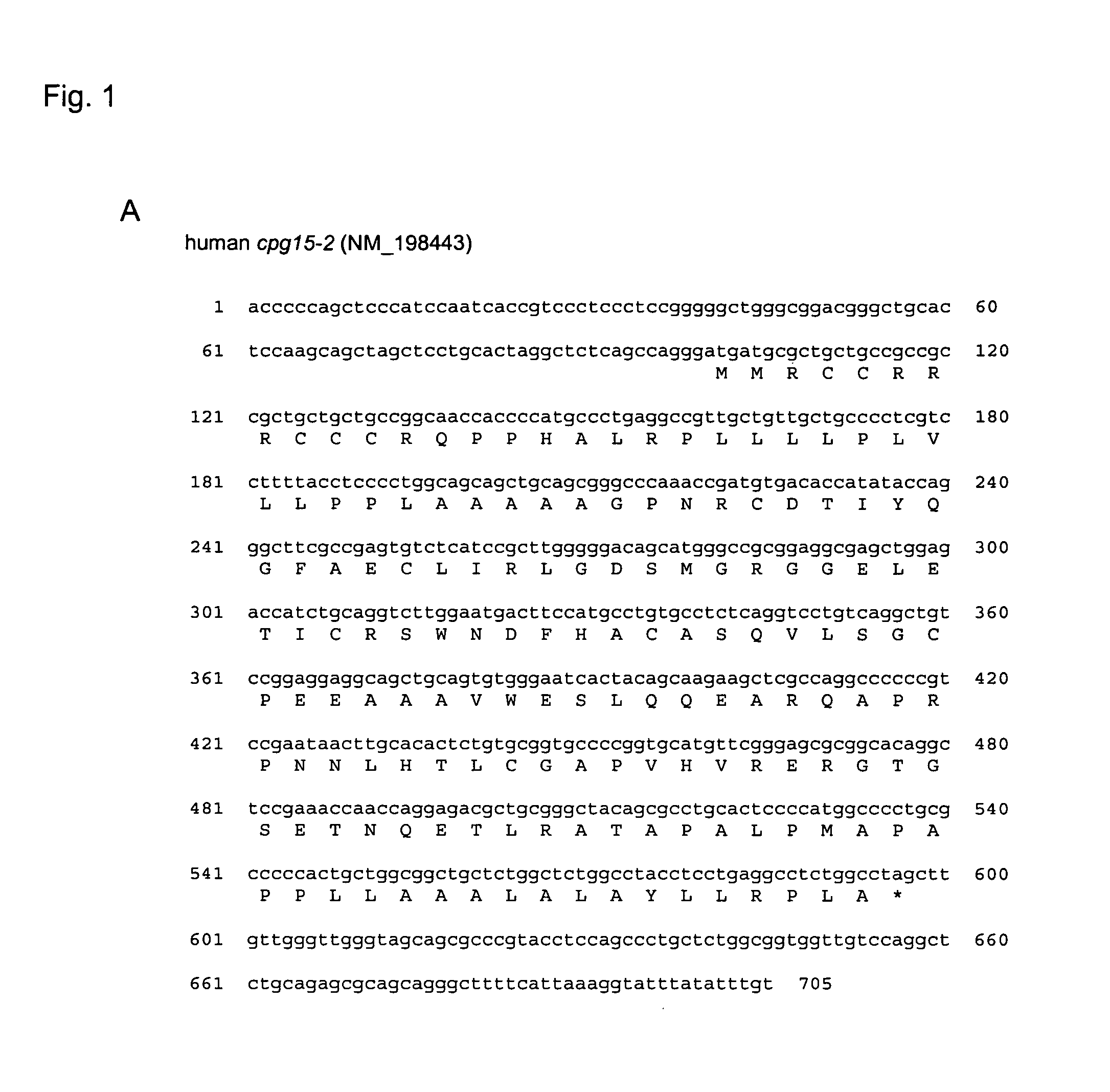Methods and compositions for CPG15-2
- Summary
- Abstract
- Description
- Claims
- Application Information
AI Technical Summary
Benefits of technology
Problems solved by technology
Method used
Image
Examples
example 1
Isolation and Sequence Analysis of cpg15-2
[0189] cpg15-2 was identified in a Genbank database search for genes encoding proteins similar to human CPG15 / neuritin (accession number AF136631) using the BLASTP program (http: / / www.ncbi.nlm.nih.gov / blast / ) with default settings. The search yielded a human predicted mRNA MRCC2446 (accession number NM—198443) that we termed human cpg15-2 (FIG. 1A) and a mouse cDNA clone G630049C14 (accession number AK090312) we termed mouse cpg15-2 (FIG. 1B). The mouse clone shared 34% identity and 59% similarity at the amino acid level with mouse CPG15 (FIG. 1A). No other mouse sequence with significant similarity was found, suggesting that cpg15 and cpg15-2 are the only members of this gene family in mouse.
[0190] The mouse cpg15-2 cDNA was isolated from adult mouse brain RNA by RT-PCR. For RT-PCR, poly (A)+ RNA was reverse transcribed using the SuperScript first-strand synthesis system for RT-PCR (Invitrogen, Carlsbad, Calif.), and the coding region of ...
example 2
Developmental and Tissue Specific Expression of cpg15-2 mRNA
[0195] To being characterizing cpg15-2, we used Northern blot analysis to examine its expression in the mouse brain. For RNA preparation from kainate injected mice, cerebral cortices were harvested 6 hours after intraperitoneal injection of kainate (25 mg / kg) in PBS. Northern blot hybridization was done as described Sambrook et al., supra) with the following modifications. Poly (A)+ RNA selection was done using Oligotex (Qiagen, Valencia, Calif.). Ten micrograms of poly (A) enriched RNA was separated on 1% agarose gel containing formaldehyde, transferred to a nylon membrane, and hybridized with 32P-labeled probes using stringent conditions. Probes were synthesized using the High Prime labeling kit (Roche, Indianapolis, Ind.) from the 1.6 kb mouse cpg15 cDNA fragment, 0.5-kb mouse cpg15-2 cDNA fragment or the 316-bp mouse GAPDH cDNA fragment excised from pTRI-GAPDH-mouse (Ambion, Austin, Tex.). The blot was hybridized first...
example 3
CPG15-2 is a Glycoprotein That Exists as a Both a Membrane Bound Form and a Secreted Soluble Form
[0202] To study the biochemical properties of CPG15 and CPG15-2 proteins, we made HEK293 cells stably expressing a FLAG-tagged CPG15 or CPG15-2. The FLAG-tagged proteins were then immunoprecipitated from the cell lysate and culture supernatant using an anti-FLAG antibody, then visualized on a Western blot using the same antibody.
[0203] The FLAG or poly-histidine (His) tagged constructs were generated as follows. A FLAG or poly-histidine (His) tag was inserted after the signal peptide sequence of CPG15 and CPG15-2. An N-terminal fragment encoding the signal peptide and a tagged C-terminal fragment encoding the core domain and the GPI-anchoring signal were each generated by PCR from the full length cDNA with the following primers.
[0204] His-tagged cpg15 N-terminal fragment:
(SEQ ID NO: 13)5′-GGAATTCGCCACCATGGGACTTAAGTTGAACGG-3′and(SEQ ID NO 14);5′-GGGGTACCGCCTGCTGCTCTCACGG-3′
[0205] His...
PUM
| Property | Measurement | Unit |
|---|---|---|
| Fraction | aaaaa | aaaaa |
| Fraction | aaaaa | aaaaa |
| Fraction | aaaaa | aaaaa |
Abstract
Description
Claims
Application Information
 Login to View More
Login to View More - R&D
- Intellectual Property
- Life Sciences
- Materials
- Tech Scout
- Unparalleled Data Quality
- Higher Quality Content
- 60% Fewer Hallucinations
Browse by: Latest US Patents, China's latest patents, Technical Efficacy Thesaurus, Application Domain, Technology Topic, Popular Technical Reports.
© 2025 PatSnap. All rights reserved.Legal|Privacy policy|Modern Slavery Act Transparency Statement|Sitemap|About US| Contact US: help@patsnap.com



